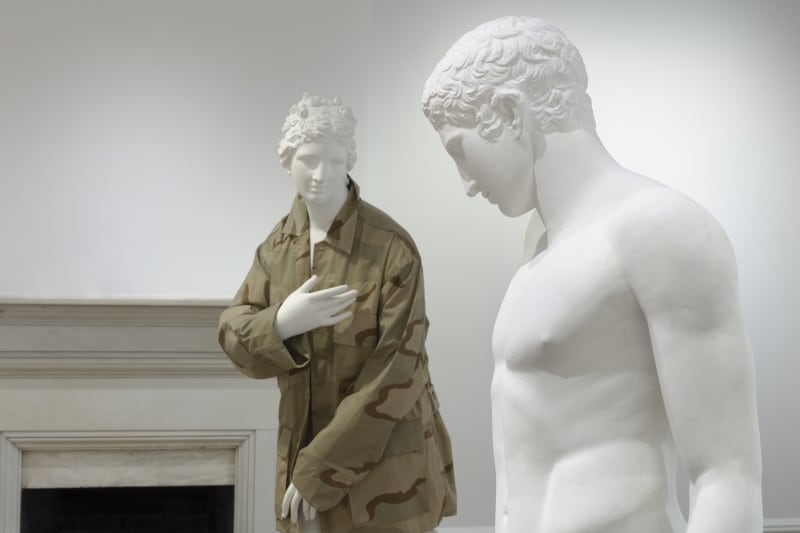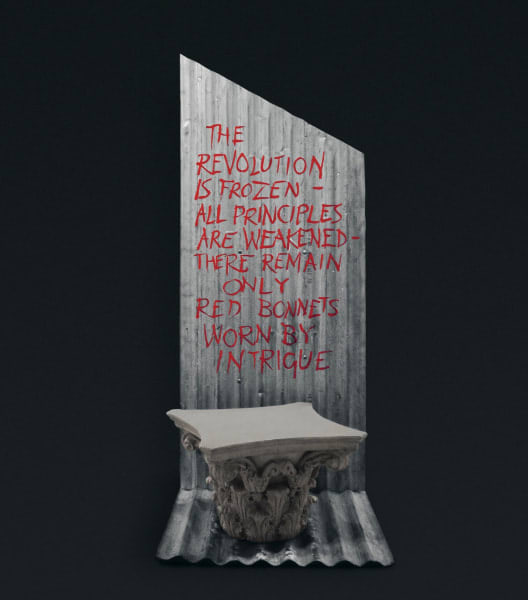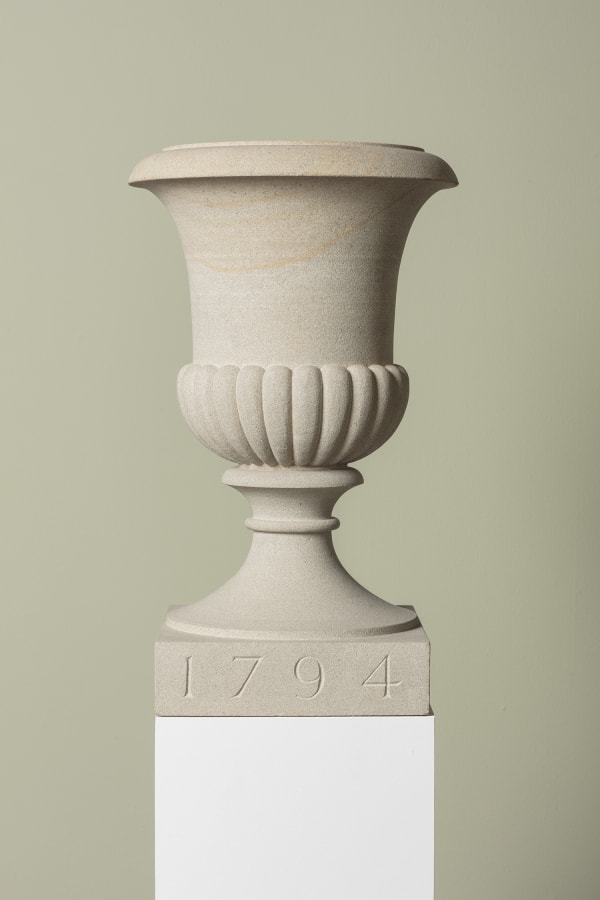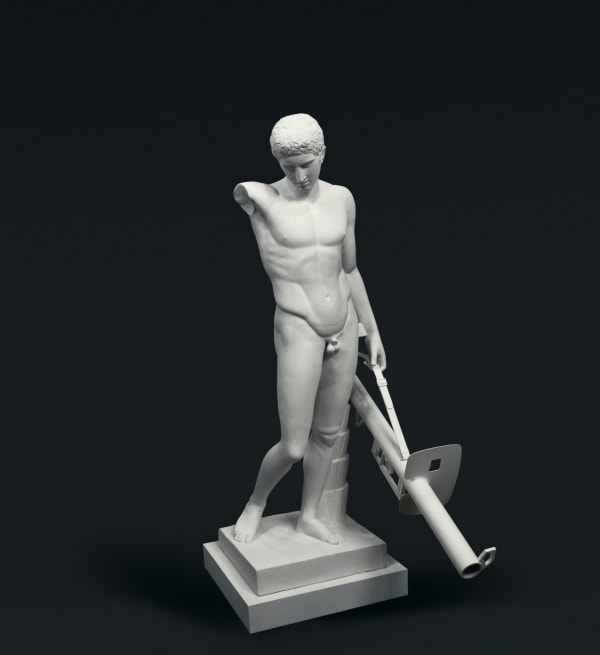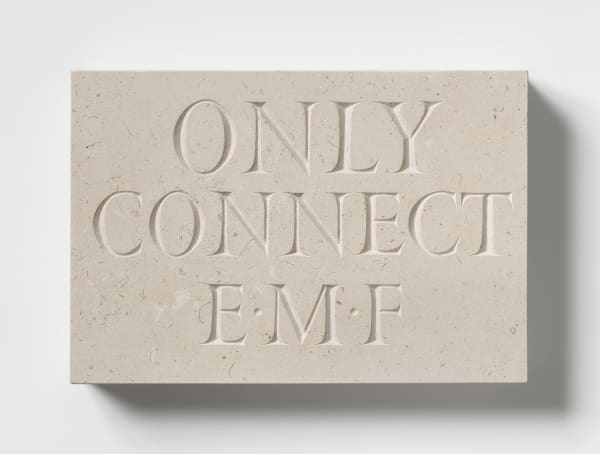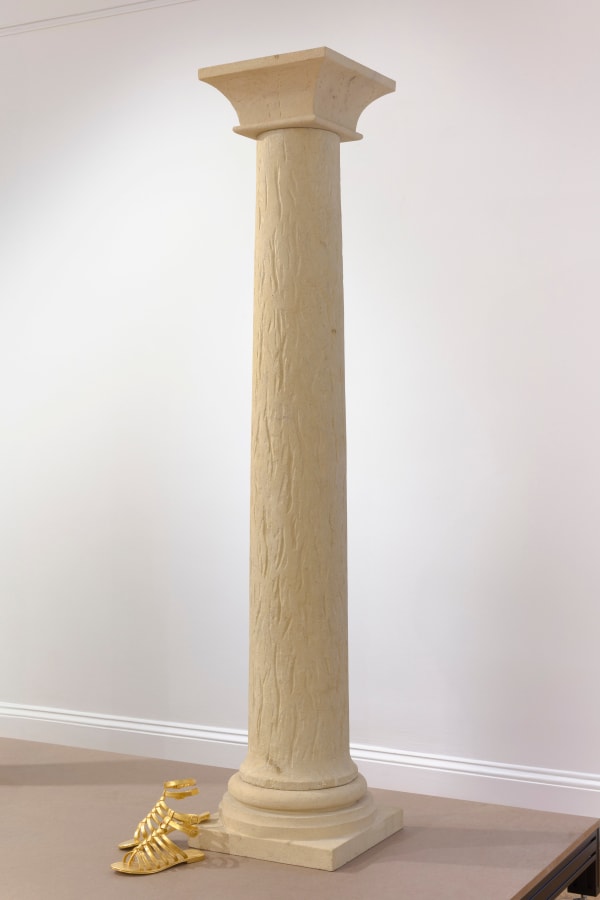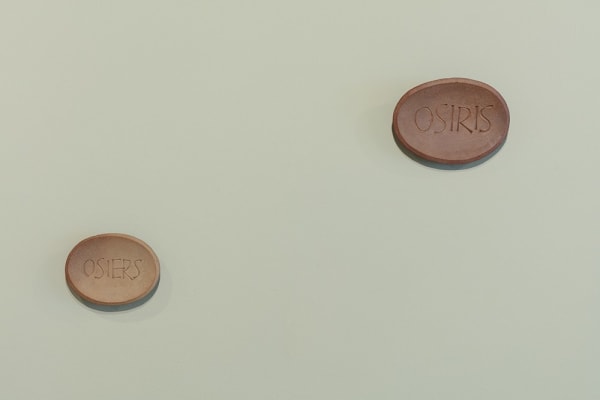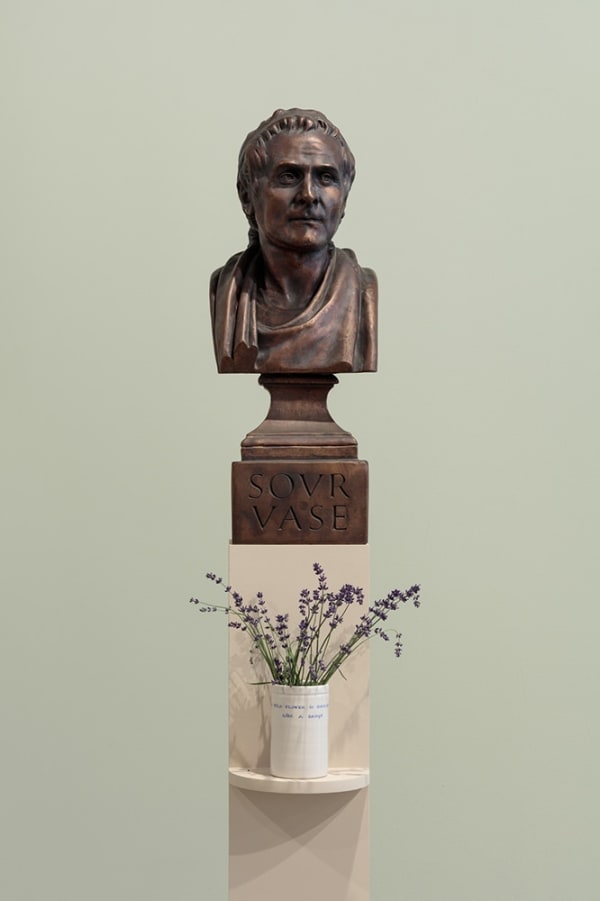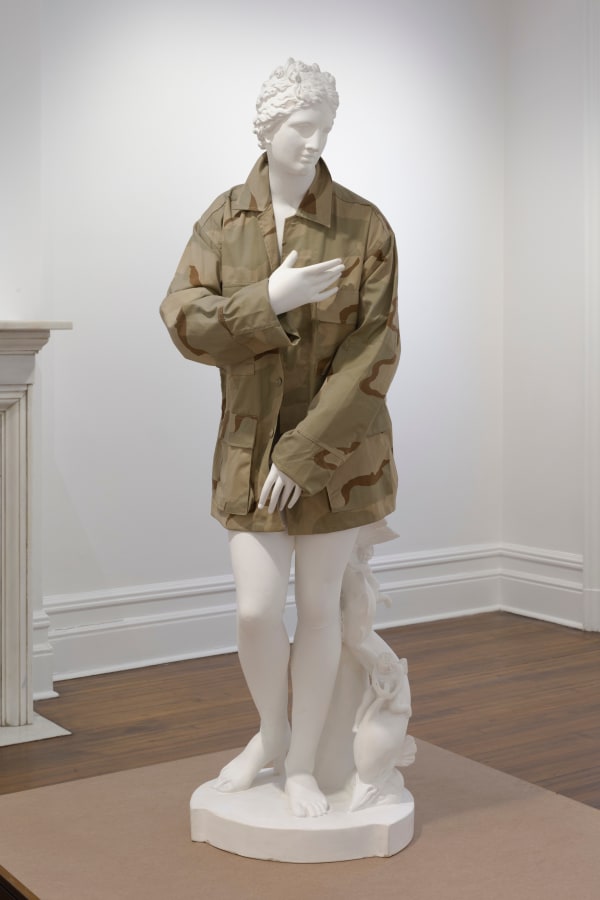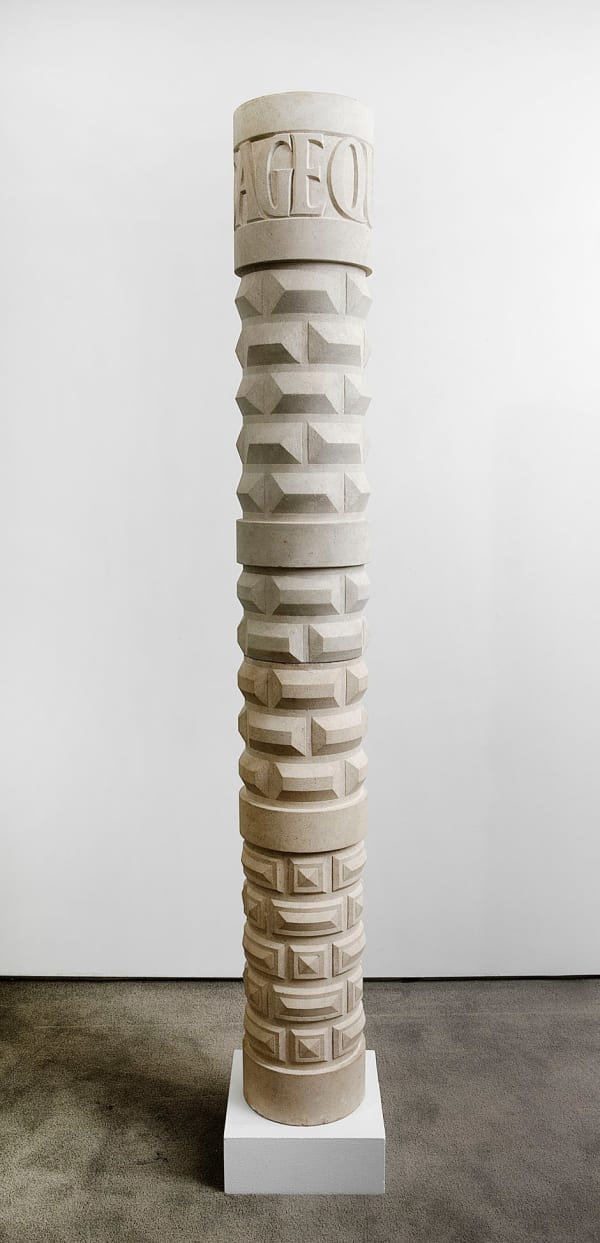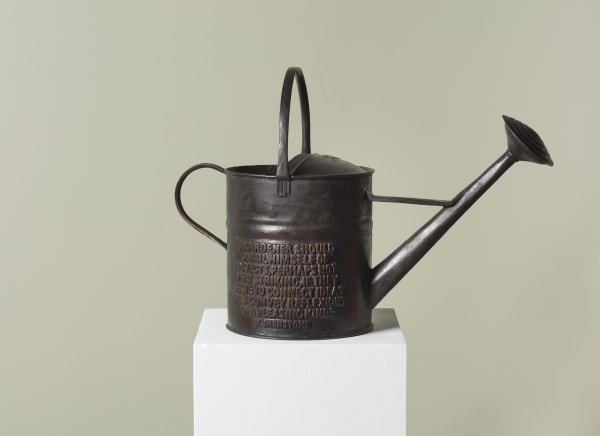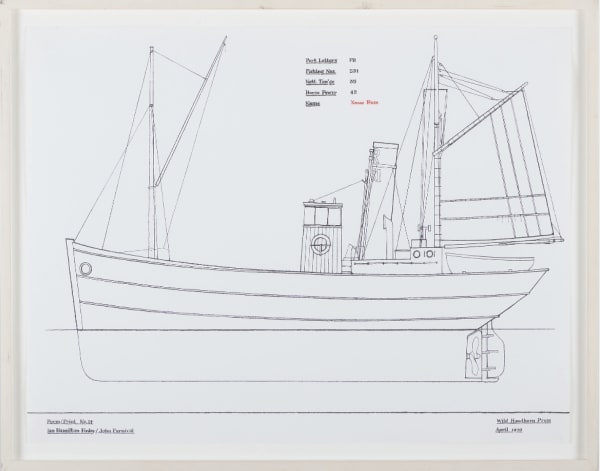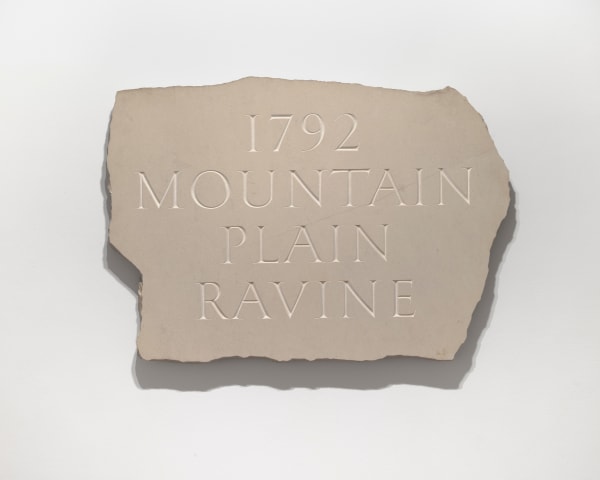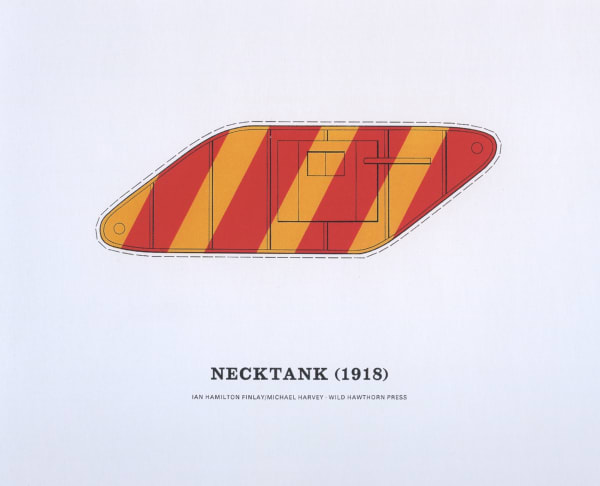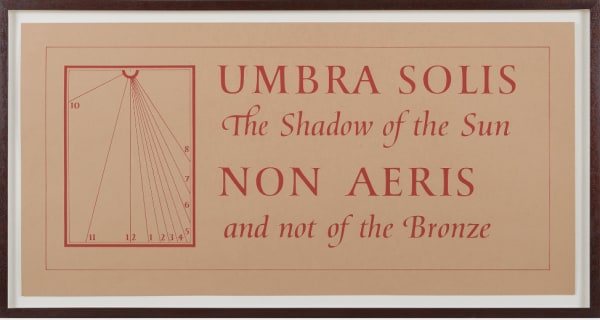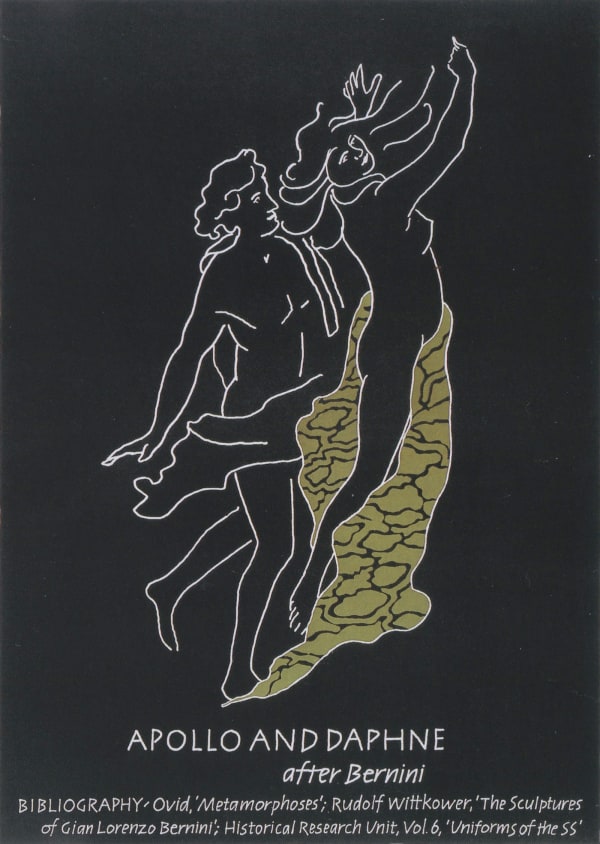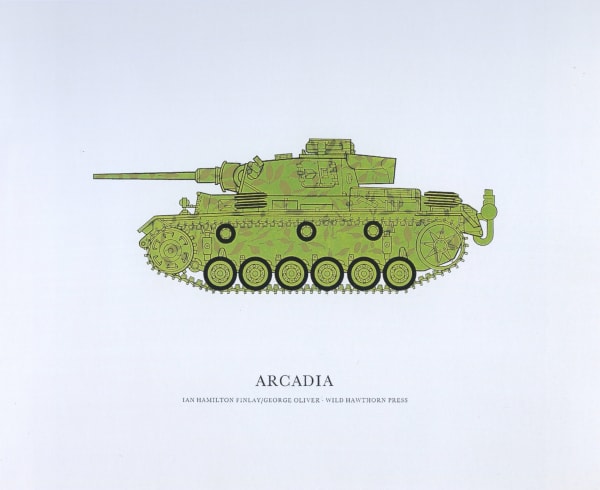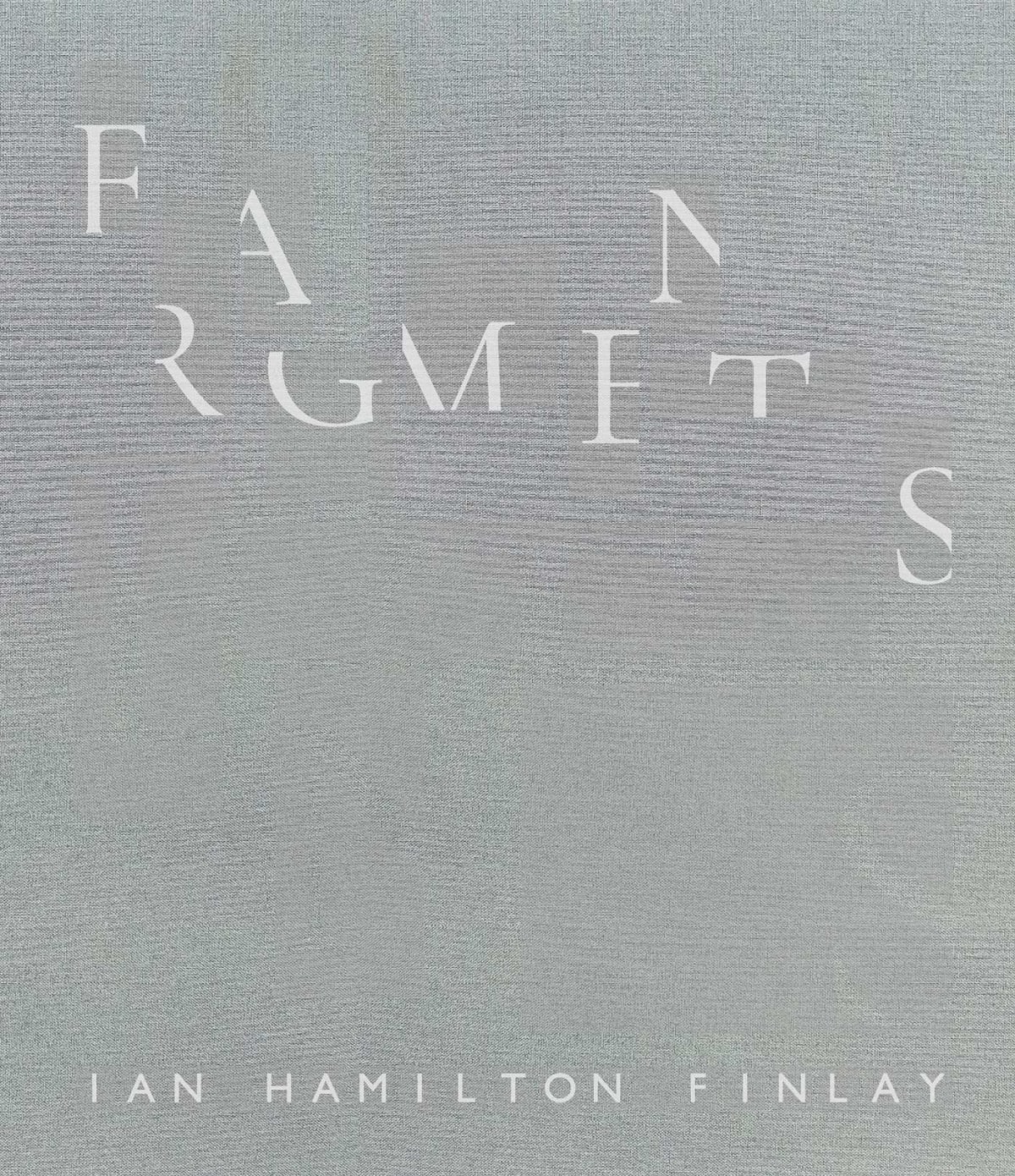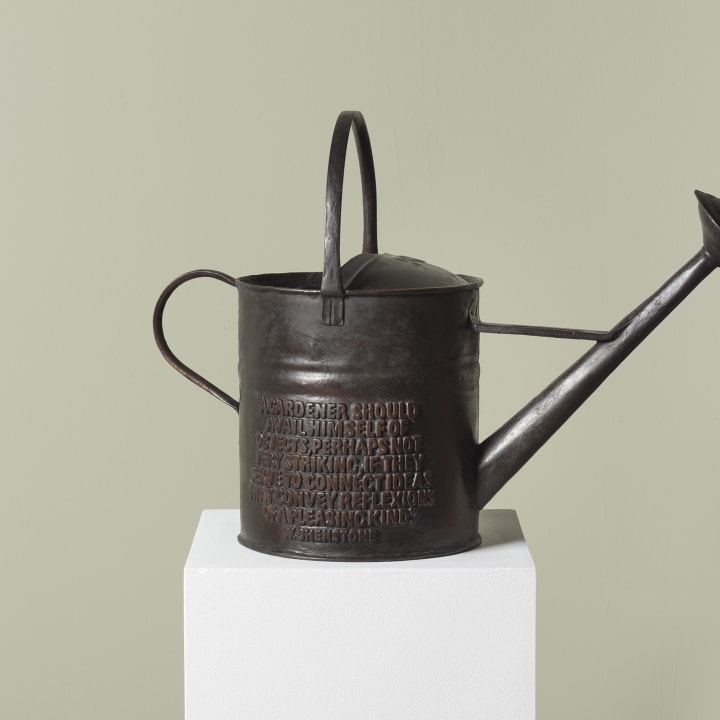IAN HAMILTON FINLAY: Fragments: Celebrating the Artist's Centennial | Exhibition Design by David Hartt
-
Overview
David Nolan Gallery is pleased and greatly honored to present an exhibition marking the centennial of the birth of Ian Hamilton Finlay (1925–2006). One of Scotland’s most celebrated artists, poets, and philosophers, Finlay revitalized the classical tradition in a body of work that spans multiple disciplines, emphasizing the enduring power of the word. The gallery has proudly exhibited his works for over thirty years, and this exhibition is part of Ian Hamilton Finlay: Fragments, a major international project which includes a newly published book and eight exhibitions across the USA, England, Scotland, Germany, Switzerland, Austria, Italy, and Spain in May 2025, curated and edited by Pia Maria Simig. The exhibition at David Nolan Gallery is the only one in the Americas and is designed by Philadelphia-based, Canadian artist David Hartt.
Ian Hamilton Finlay’s Practice
Finlay’s work is difficult to classify. He collaborated with traditional craftsmen, architects and contemporary artists creating work across several disciplines. Some know him as Britain’s foremost concrete poet, pioneering the movement through Wild Hawthorn Press, which he co-founded in 1961. Others see him primarily as a gardener; his magnum opus being Little Sparta, a poetic garden in the Pentland Hills near Edinburgh. Spread over seven acres of wild, exposed moorland, and containing over 270 sculptures, Little Sparta was the focus of Finlay’s artistic dedication since his arrival at the farm with his family in the autumn of 1966 and until his death in 2006. His art lives on in museums, parks, and gardens worldwide, resisting the conventional and simplistic labels of conceptual, postmodern, or classical. Above all, Finlay considered himself a poet with much of his work hovering on the borderline between poetry and some other medium. He worked with and through poetics, by using language, materials, and moments that he created in his Garden Temple.Drawing from philosophy, history, and mythology, Finlay spent nearly forty years developing a rigorous and intricate body of work. His concrete poetry—where the form is as important as the meaning—confronts Western cultural values, referencing the French Revolution, World War II, and classical civilizations. Beauty, violence and the sacred coalesce in his works mirroring the dissolution of ideals in contemporary politics and culture at large. Believing that the positive Western symbols had been drained of their meaning by consumerist assimilation, he turned to emblems of power and aggression—machine guns, tanks, guillotines—symbols that, unlike commercialized imagery, retained their potency. His art explores the tension between fixed ideas and shifting moods, and between culture and nature.
The Exhibition
Ian Hamilton Finlay: Fragments presents works from the late 1970s to the late 1990s, ranging across porcelain, ceramic, stone, bronze, plaster, and metal sculptures, as well as prints. Each work speaks to themes central to Finlay’s practice—poetry and wordplay, romanticized notions of the classical, the limits of interpretation, and the interweaving of religious, political, and aesthetic power.In ROUSSEAU (Sour Vase) / A Wild Flower is Ideological, Like a Badge, a cast bronze bust of philosopher and writer, Jean-Jacques Rousseau is paired with a ceramic vase. The bust replicates Jean-Antoine Houdon’s 1780 sculptural portrait of the philosopher who inspired the leaders of the French Revolution, while the phrase “SOUR VASE” is an anagram, in Roman letters, of “ROUSSEAU.” This linguistic play suggests a tension between the “vase” of Rousseau’s thought, which is elegant and vibrant, and its contents, which are politically provocative, even corrosive (“sour”). The wildflower placed within, emblematic of innocence, purity and liberty, alludes to Rousseau’s radical belief in nature as humanity’s most fulfilling state, untouched by society’s corrupting forces.
The Revolution is Frozen—All Principles Are Weakened. There Remain Only Red Bonnets Worn by Intrigue takes the form of an assemblage of corrugated steel, paint, and faux stone (a prefabricated Corinthian capital). The corrugated metal mimics the fluting of a classical column, while the inscribed text alludes both to the aesthetics of ancient inscriptions and contemporary urban graffiti. The phrase originates from a speech by Saint-Just, a major figure of the French Revolution. Finlay also references Hegel’s Philosophy of History, particularly its critique of religion’s diminishing engagement with beauty. The work is a multi-layered reflection on the aftereffects of revolution, where radical ideals disintegrate, leaving behind only their emptied symbols.
In Aphrodite of the Pastoral, the goddess of love, beauty, and fertility wears a jacket patterned with U.S. army desert camouflage, as though she is ashamed of the power of her own nakedness or subsumed by militaristic power. Camouflage, a means of and metaphor for concealment, here conveys the moral ambiguity of unchecked force. Traditionally, pastoral poetry idealizes a rural landscape where shepherds sing of love and harmony. Yet, in Finlay’s vision, Aphrodite has been exiled from Mount Olympus and finds refuge in a landscape shadowed by loss and violence. The work suggests a corrupted pastoral, where materialism and secularism are concealing beauty and transcendence.
Dryad recalls classical mythology, where dryads were wood nymphs inhabiting oak trees. The earliest Greek temples, whose unadorned Doric columns mirrored sacred oaks, retain this symbolism. Here, a column with proportions modeled on the human body bears a rippling carved bark pattern, suggesting the tree that once was. A pair of golden sandals, left behind in the dryad’s hasty metamorphosis into tree and then column, marks her divine presence. In this poetic transformation, where the tree becomes a goddess, and the goddess becomes stone—her physical form has departed, yet vividly re-conjured through metaphor.
Ian Hamilton Finlay’s works provoke meditation, linking the Classical, Renaissance, and Modern eras into an intricate web of cultural resonance. His legacy is not just in the objects he created but in the intellectual and poetic space they open—a critical reflection on the evolution of Western civilization. By its very structure, his work enacts the cultural fabric it dissects, activating history through form, text, and metaphor.
Exhibition Design
Designed by David Hartt (b. 1967), the exhibition reflects his signature approach—bridging past and present through meticulous historical research. Exhibition design has increasingly become part of Hartt’s artistic practice, and this project emerged from a shared kinship between Finlay’s work and his own. After visiting Little Sparta in 2022, a trip he describes as a pilgrimage, Hartt embraced the connection between his and Finlay’s work, and this connection is now formalized in this exhibition. Both artists share a deep engagement with language and design, encoding their works with layered historical references. Finlay frequently employed the technique of détournement, or subverting existing objects or ideas by erasing and rewriting their histories to critique their underlying ideology. His works often resemble relics from antiquity, inviting deeper examination. Hartt, while not using détournement in the same way, uncovers buried histories, a process which similarly requires intervention.For this exhibition, Hartt draws inspiration from Italian architect and designer Carlo Scarpa, whose elegant integration of contemporary design with historical artifacts provides a model for mediation between past and present. Hartt further considers how the work is socialized, both amongst the different pieces but also in relation with the viewer, creating an experience that reflects Finlay’s own preoccupations on how meaning shifts over time, and how history, language, and landscape shape our perception of the world.
- Tharini Sankarasubramanian
Ian Hamilton Finlay: Fragments takes place in May 2025 at: David Nolan Gallery, New York; Ingleby Gallery, Edinburgh; Kewenig Gallery, Palma de Mallorca; Galleria Massimo Minini, Brescia; Victoria Miro, London; Sfeir-Semler Gallery, Hamburg; Stampa Galerie, Basel; Galerie Hubert Winter, Vienna.
Ian Hamilton Finlay: Fragments (Book release)
Published on 8 May 2025 by ACC Art Books and edited by Pia Maria Simig, Fragments draws together one hundred works by Ian Hamilton Finlay, each accompanied by a short, fragmentary text by the artist and myriad distinguished writers who wrote about Finlay’s work during his lifetime. It features introductory essays by Stephen Bann (CBE, Emeritus Professor of History of Art at the University of Bristol) and Tom Lubbock (chief art critic of The Independent from 1997 until his death in 2011) and includes 100 full colour plates. Additional texts by: Yves Abrioux, Stephen Bann, Prudence Carlson, Patrick Duncombe, Julia Eames, Patrick Eyres, Alec Finlay, Ian Hamilton Finlay, George Gilliland, Harry Gilonis, and Tom Lubbock. Designed by John and Orna Designs. -
Installation Views
-
-
 Ian Hamilton FinlayThe Revolution is Frozen—All Principles Are Weakened. There Remain Only Red Bonnets Worn by Intrigue, 1991corrugated steel, paint and faux stone65 3/4 x 26 3/4 x 24 1/2 in (167 x 68 x 62 cm)
Ian Hamilton FinlayThe Revolution is Frozen—All Principles Are Weakened. There Remain Only Red Bonnets Worn by Intrigue, 1991corrugated steel, paint and faux stone65 3/4 x 26 3/4 x 24 1/2 in (167 x 68 x 62 cm) -
 Ian Hamilton FinlayUrn 1794, 1993stone, with Peter Coates17 3/4 x 10 5/8 x 10 5/8 in (45 x 27 x 27 cm)
Ian Hamilton FinlayUrn 1794, 1993stone, with Peter Coates17 3/4 x 10 5/8 x 10 5/8 in (45 x 27 x 27 cm) -
 Ian Hamilton FinlayMan With Panzerschreck, 1993plaster and metal61 x 17 3/8 x 19 1/4 in (155 x 44 x 49 cm)
Ian Hamilton FinlayMan With Panzerschreck, 1993plaster and metal61 x 17 3/8 x 19 1/4 in (155 x 44 x 49 cm) -
 Ian Hamilton FinlayOnly Connect, 1998stone, with John Andrew7 7/8 x 11 1/2 x 1 7/8 in (20 x 29.2 x 4.7 cm)
Ian Hamilton FinlayOnly Connect, 1998stone, with John Andrew7 7/8 x 11 1/2 x 1 7/8 in (20 x 29.2 x 4.7 cm) -
 Ian Hamilton FinlayDryad, 1987stone and metal, with John Sellman and Eva Bai74 x 15 1/2 x 15 1/2 in (188 x 39.5 x 39.5 cm)
Ian Hamilton FinlayDryad, 1987stone and metal, with John Sellman and Eva Bai74 x 15 1/2 x 15 1/2 in (188 x 39.5 x 39.5 cm) -
 Ian Hamilton FinlayOsiris, Osiers, 1983two ceramic tree plaques, with David Ballantyne10 1/4 x 7 7/8 x 1 5/8 in (26 x 20 x 4 cm)
Ian Hamilton FinlayOsiris, Osiers, 1983two ceramic tree plaques, with David Ballantyne10 1/4 x 7 7/8 x 1 5/8 in (26 x 20 x 4 cm)
8 5/8 x 6 1/2 x 1 5/8 in (22 x 16.5 x 4 cm) -
 Ian Hamilton FinlayROUSSEAU (Sour Vase) / A Wild Flower is Ideological, Like a Badge, 1991-93cast bronze and ceramic vase (vase with David Ballantyne)cast bronze: 27 1/2 x 10 1/2 x 11 in (69.8 x 26.7 x 27.9 cm)
Ian Hamilton FinlayROUSSEAU (Sour Vase) / A Wild Flower is Ideological, Like a Badge, 1991-93cast bronze and ceramic vase (vase with David Ballantyne)cast bronze: 27 1/2 x 10 1/2 x 11 in (69.8 x 26.7 x 27.9 cm)
ceramic vase: 5 1/2 x 3 3/8 in (13.9 x 8.5 cm) -
 Ian Hamilton FinlayEvery Goal Negates (L. Feuerbach), with John Andrew, 1987stone16 1/8 x 106 1/4 x 1 1/8 in (41 x 270 x 3 cm)
Ian Hamilton FinlayEvery Goal Negates (L. Feuerbach), with John Andrew, 1987stone16 1/8 x 106 1/4 x 1 1/8 in (41 x 270 x 3 cm) -
 Ian Hamilton FinlayAphrodite of the Pastoral, 1993plaster and US Army desert sand camouflage jacket60 1/4 x 18 x 21 in (153 x 45.7 x 53.3 cm)
Ian Hamilton FinlayAphrodite of the Pastoral, 1993plaster and US Army desert sand camouflage jacket60 1/4 x 18 x 21 in (153 x 45.7 x 53.3 cm) -
 Ian Hamilton FinlayAge Quod Agis / Rubbing Post for a Wild Boar, 1997stone, with Peter Coates60 1/4 x 8 1/8 in (153 x 20.6 cm)
Ian Hamilton FinlayAge Quod Agis / Rubbing Post for a Wild Boar, 1997stone, with Peter Coates60 1/4 x 8 1/8 in (153 x 20.6 cm) -
 Ian Hamilton FinlayWatering Can (Shenstone), 1995bronze, with John Andrew15 3/4 x 23 1/2 x 11 3/4 in (40 x 60 x 30 cm)
Ian Hamilton FinlayWatering Can (Shenstone), 1995bronze, with John Andrew15 3/4 x 23 1/2 x 11 3/4 in (40 x 60 x 30 cm) -
 Ian Hamilton FinlayPoem Print No. 14 (with John Furnival), 1970screenprint in black and red on wove paper20 x 27 in (50.8 x 68.6 cm)
Ian Hamilton FinlayPoem Print No. 14 (with John Furnival), 1970screenprint in black and red on wove paper20 x 27 in (50.8 x 68.6 cm)
framed: 22 3/4 x 30 5/8 in (57.8 x 77.8 cm) -
 Ian Hamilton Finlay1792 Mountain Plain Ravine, 1994Purbeck Portland stone, with Annet Stirling30 x 43 1/4 x 2 in (76.2 x 109.9 x 5.1 cm)
Ian Hamilton Finlay1792 Mountain Plain Ravine, 1994Purbeck Portland stone, with Annet Stirling30 x 43 1/4 x 2 in (76.2 x 109.9 x 5.1 cm) -
 Ian Hamilton FinlayNecktank (with Michael Harvey), 1973screenprint in red, orange, and black on wove paper14 x 17 1/4 in (35.6 x 43.8 cm)edition of 250
Ian Hamilton FinlayNecktank (with Michael Harvey), 1973screenprint in red, orange, and black on wove paper14 x 17 1/4 in (35.6 x 43.8 cm)edition of 250 -
 Ian Hamilton FinlayUmbra Solis (with Michael Harvey), 1975screenprint in red on beige paper14 1/2 x 29 1/2 in (36.8 x 74.9 cm)
Ian Hamilton FinlayUmbra Solis (with Michael Harvey), 1975screenprint in red on beige paper14 1/2 x 29 1/2 in (36.8 x 74.9 cm)
framed: 17 1/8 x 32 1/8 in (43.5 x 81.4 cm) -
 Ian Hamilton FinlayAPOLLO AND DAPHNE AFTER BERNINI, 1977screenprint19 1/2 x 14 1/4 in (49.5 x 36.2 cm)
Ian Hamilton FinlayAPOLLO AND DAPHNE AFTER BERNINI, 1977screenprint19 1/2 x 14 1/4 in (49.5 x 36.2 cm)
framed: 22 3/4 x 16 3/4 in (57.8 x 42.5 cm) -
 Ian Hamilton FinlayArcadia (with George Oliver), 1973screenprint in green and black on wove paper13 3/4 x 17 1/8 in (34.9 x 43.5 cm)
Ian Hamilton FinlayArcadia (with George Oliver), 1973screenprint in green and black on wove paper13 3/4 x 17 1/8 in (34.9 x 43.5 cm)
framed: 16 1/8 x 19 3/8 in (41 x 49.1 cm)edition of 250
-
-
PRESS
-
Ian Hamilton Finlay: Fragments
Alfred Mac Adam · Brooklyn Rail May 21, 2025Gardening may be divided into three species: kitchen gardening—parterre-gardening—and landskip, or picturesque-gardening… It consists in pleasing the imagination by scenes of grandeur, beauty, or variety. Convenience merely has no share... -
Ian Hamilton Finlay at 100: A Century of Concrete Poetry and Classical Resistance
Artnet Gallery Network · Artnet May 15, 2025In New York, David Nolan Gallery presents a centennial exhibition on the pioneering artist, poet, and gardener. Artist, poet, philosopher, gardener, the multihyphenate Ian Hamilton Finlay (1925–2006) created a body... -
What's on our Cultural Calendar this May
Ingrid Abramovitch · Elle Decor May 13, 2025Our editors’ picks for the best design, art, and architecture happenings around. IAN HAMILTON FINLAY: FRAGMENTS AT DAVID NOLAN GALLERY New York City Philosopher. Sculptor. Poet. Gardener. The late Scottish... -
The polarising poet, sculptor and ‘avant-gardener’ who maintained a private militia
Digby Warde-Aldam · The Spectator April 26, 2025On the centenary of his birth, we remember visionary artist Ian Hamilton Finlay, whose heavies, the 'Saint-Just Vigilantes’, once vandalised the offices of Apollo magazine Not many artists engage in... -
Written on Tablets of Stonypath
Alec Finlay · The World of Interiors April 23, 2025The poet and artist Ian Hamilton Finlay was a man of fragile disposition and fixed – but not always logical – views. He made model toys that weren’t to be... -
Ian Hamilton Finlay: The groundbreaking artist and poet who created ‘Little Sparta’
Tom Lubbock · The Independent April 21, 2025The revolutionary Scotsman, who created in his Lanarkshire garden 'Little Sparta', would have turned 100 this year Ian Hamilton Finlay, poet and artist: born Nassau, Bahamas 28 October 1925; CBE... -
Dare you journey to Little Sparta — a point of no return?
Natalie Whittle · Financial Times April 18, 2025On the centenary of the birth of Ian Hamilton Finlay — poet, iconoclast, social revolutionary and maritime obsessive — his Scottish garden is being celebrated as his greatest work of... -
Ian Hamilton Finlay review – the visionary Scottish poet-artist’s mind in closeup
Laura Cumming · The Guardian March 23, 2025Words and ideas are as one – and at war – in Finlay’s witty, elegant work, from sculptures to screenprints, which are ideally displayed in this intimate centenary show Star/Steer... -
Who was Ian Hamilton Finlay? — Scotland’s greatest (unknown) artist
Magnus Linklater · The Times March 1, 2025Nine international exhibitions will celebrate the centenary of the creator who was revered for his rebellious nature but had a gentler soul at heart H e was the greatest Scottish... -
The centenary of celebrated Scottish artist Ian Hamilton Finlay
Charlotte Cohen · The Herald February 28, 2025Ian Hamilton Finlay 8 March-25 May. Entry free. Scottish National Gallery of Modern Art, 75 Belford Road, Edinburgh, EH4 3DR. The centenary of celebrated Scottish artist Ian Hamilton Finlay is... -
Centenary celebrations for the unpredictable poetry pioneer Ian Hamilton Finlay
The Art Newspaper February 28, 2025Work of the late Scottish artist—known for his “concrete“ poetry, Little Sparta garden and prickly personality—to go on show in Edinburgh Poet, sculptor, printmaker, gardener, designer… Ian Hamilton Finlay defied... -
March's must-see exhibitions: Edvard Munch, Roman marvels and an overlooked artist who ‘revolutionised’ sculpture
The Art Newspaper February 28, 2025The Art Newspaper's pick of the top shows to see around the world this month As the art world regroups after Frieze Los Angeles —and the city's artists continue to...
-
-
Publications
-
Artist
